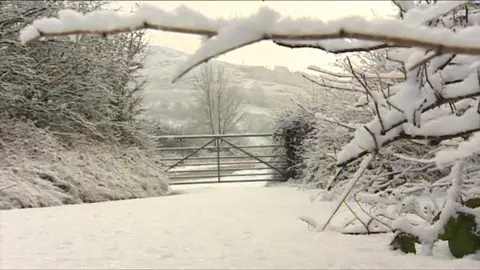White Christmas: How common is it in Wales?
 Getty Images
Getty ImagesAre you dreaming of a white Christmas?
All it takes is for a single snowflake to be observed falling at any time on Christmas Day somewhere in the UK.
So, an official white Christmas may not appear snowy at all, while snow lying on the ground is no guarantee.
But while most festive films, songs and cards feature snowy scenes, how likely is a white Christmas in Wales' mild - and warming - climate?
How many white Christmases have there been in Wales?
In the 60 years since the Met Office has recorded the data locally, 23 Christmases have officially been white in Wales.
This equates to roughly four in every decade, or a white Christmas every two to three years.
However, more than a quarter of these white Christmases have seen snow fall in only one location.
Only six Christmas Days have seen snowfall in more than 10 locations over this period, and all of these were in an 11-year span.
 Getty Images
Getty ImagesThe first of these was in 1993, when 24 weather stations reported snowfall, before this peaked at 38 locations in 1995.
Other white Christmases followed in 1999, 2000, 2001 and 2004.
But a white Christmas does not necessarily mark the arrival of snowmen in gardens and parks.
The most recent significant amount of lying snow recorded in Wales on Christmas Day was in 2009, when 16cm (6in) was recorded at the Llanglunllo station in rural Powys.
That year saw the longest spell of freezing and snowy weather over the Christmas period in 28 years, according to Oli Claydon, from the Met Office.
He added: "Although we're recording white Christmases, they're not exactly 'get your sledge out territory'."

Where has seen the most snowy Christmas days?
It can be tough to definitively say where has seen the most snowy Christmas days in Wales, as some weather stations have opened more recently than others, and Met Office stations do not cover all areas.
Since records started in 1960, the weather station at Llanarmon Dyffryn Ceiriog, in Wrexham county, has seen 11 out of 60 white Christmases - and all in the last 30 years.
Dinorwic in Gwynedd and Llangunllo and Velindre in Powys have all recorded eight.
Typically, snow is more common later in the winter, with January, February and March all seeing more days of slow and sleet on average in the UK.

What about climate change?
Earlier this month, Met Office analysis suggested snowy winters may become a thing of the past in the UK within the next 20 to 40 years.
It said most of southern England would no longer see sub-zero days from 2040, while by 2060 only northern Scotland would likely experience such temperatures.
Mr Claydon said there were already signs of a reduction in snow.
"Snow days and ice days are going to reduce as we go forward. Ice days mean temperatures don't climb above 0C," he said.
"That enables lying snow to stay around for longer. Without this, the chances of lying snow reduce.
"Under a high emission scenario, by the time we get to the end of the century we are likely to see a reduction in lying snow in the UK."
